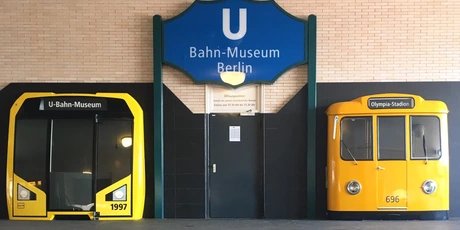
Berliner U-Bahn-Museum
Bringing technical achievements to life
Since 1997 Berlin has had its own underground museum, one of three in Europe alongside Moscow and Budapest. The transport museum is housed in one of the former historic control rooms at the Olympia Stadium metro station. Between 1931 and 1983, 616 railway lines, 99 signals and 103 switches are controlled from here. Today, find out about the history of the Berlin underground. Be amazed at the impressive exhibits and many pieces of working machinery. You can easily take a trip on a historic train at certain points throughout the year.
As if it was yesterday: time travel through the Berlin underground
By 1931, the railway switches at the Olympic Stadium are the largest in Europe. By 1983, a new track layout threatens the station's survival, but an employee protest prevents demolition. In 1997, the Berlin Underground Working Group opens the exhibition, showcasing 100 years of Berlin underground history in the interconnected rooms under the station. Many of the exhibits come from the collection of previous manager Klaus Siepert. Enter the museum between underground trains, and get your tickets from an authentic ticket machine. Look at the large wooden notice board featuring underground network plans from 1936, air raid protection measures from World War II and different messages from the police and BVG (the Berlin Transport Company).
Several exhibits also remind visitors of the division of Berlin after the war. Follow the tour to the famous signal box with its collection of network maps, signals and other artefacts, many of which are still in working order. Clothes, badges and photographs place you firmly in the 1930s. Further along, you'll find a room with 1950s flair. Of interest not only to technology fans is the still running 14 metre long control panel for signalling and rail switching, and the 1,200 signal lamps that light up your path. During a guided tour, you'll also learn about junctions, train radio, railway clocks and rare railway switches.
Berliner U-Bahn Museum highlights
- More than 300 individual items from 100 years of Berlin underground history
- Working control panel with lever mechanism from 1931
- Information desk and ticket machines dating from 1957 to 1977
- Rare switches from different types of underground trains
- Journeys on historic trains several times a year
History and art in and around the Olympiapark
It's just 10 minutes' walk from the Berliner U-Bahn-Museum to Olympiapark's Sports Museum. This is the oldest and largest museum of its kind in Germany and everything is sports related: original equipment, photographs, programmes and autographs. A brand new permanent exhibition is opening here in 2019 in a new exhibition centre within the stadium, where visitors can travel through German sporting history. Cross the Olympic Square, pass Sausuhlensee and you'll arrive at the Georg Kolbe Museum. The artist's works are displayed in his former house, studio and sculpture garden. The museum also has visiting exhibitions from artists such as Rodin or Arp. Around 4km east of the U-Bahn-Museum is one of Berlin's most famous landmarks: Charlottenburg Palace. Visit the magnificent royal rooms; see the New Pavillion, the famous porcelain collection in the Belvedere and Queen Luise's mausoleum. At Schustehruspark, visit the Villa Oppenheim where you can see an impressive collection of paintings and sculpture from the 19th century.
Berliner U-Bahn-Museum: Practical Information
The U2 line to the Olympia-Stadion will take you directly to the U-Bahn-Museum. The museum is open every second Saturday of the month. Children aged between 6 and 12 can visit for half price, and guided tours have to be booked by telephone during office hours.
2nd Saturday of the month from 10:30 a.m. to 4 p.m.


